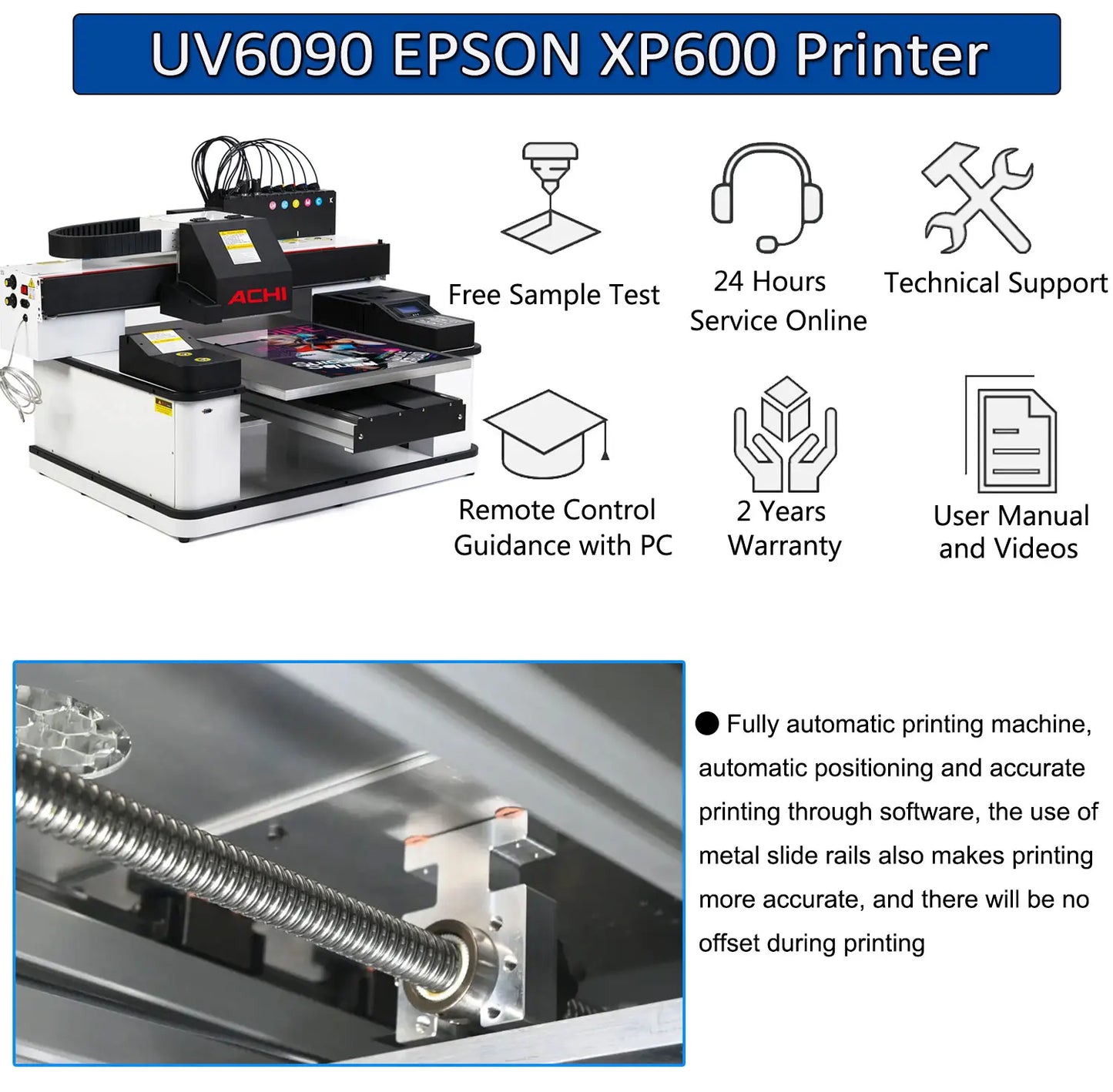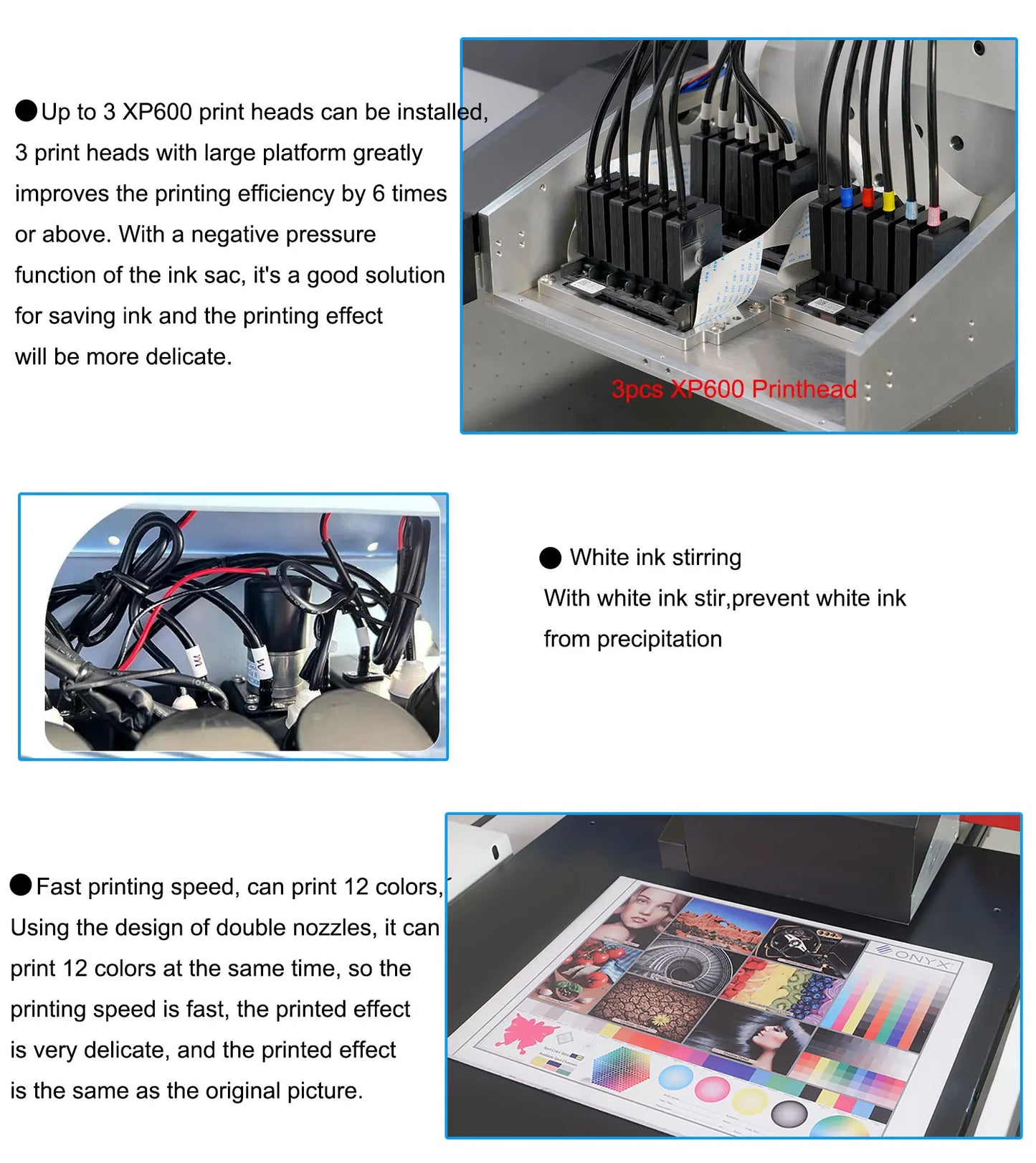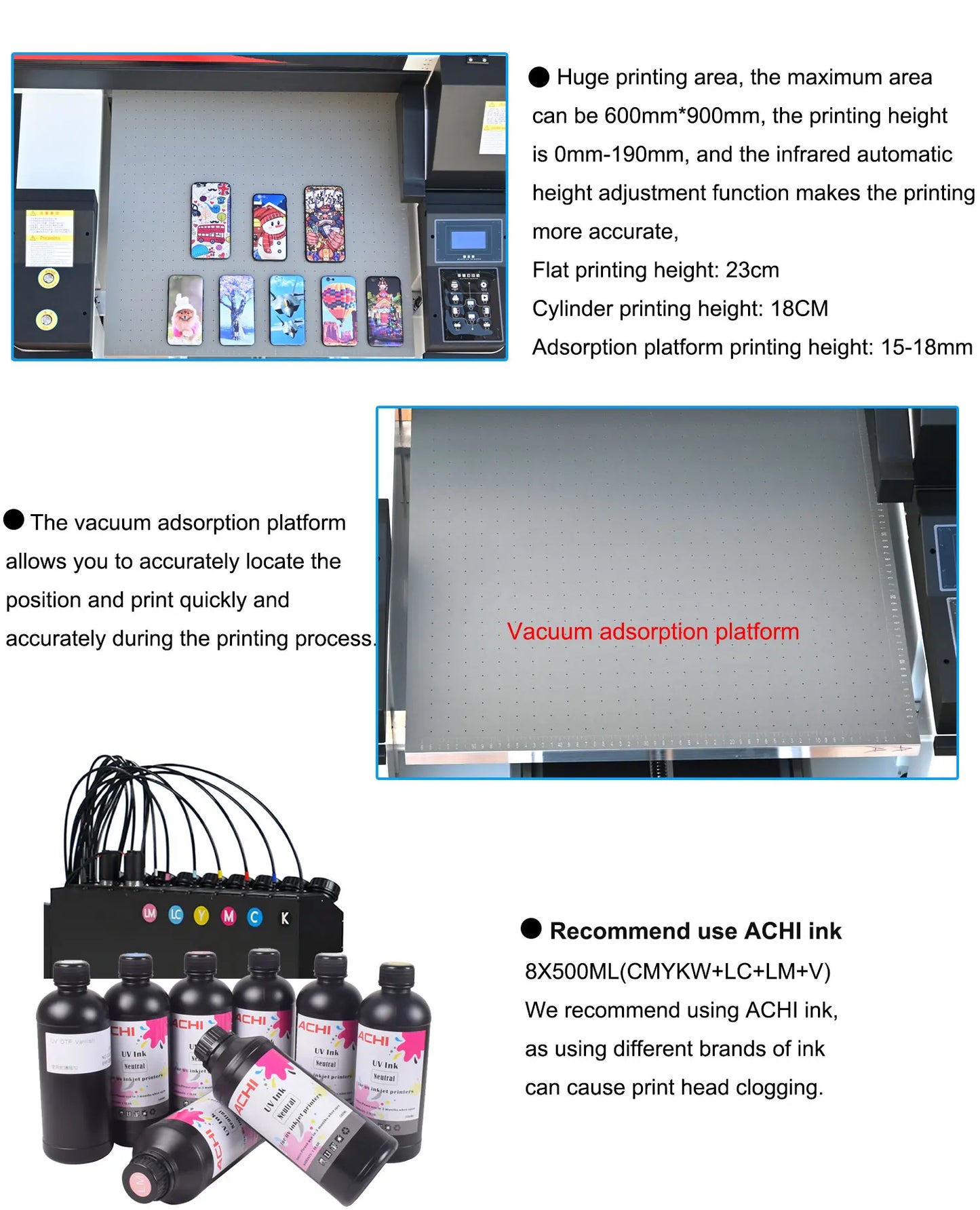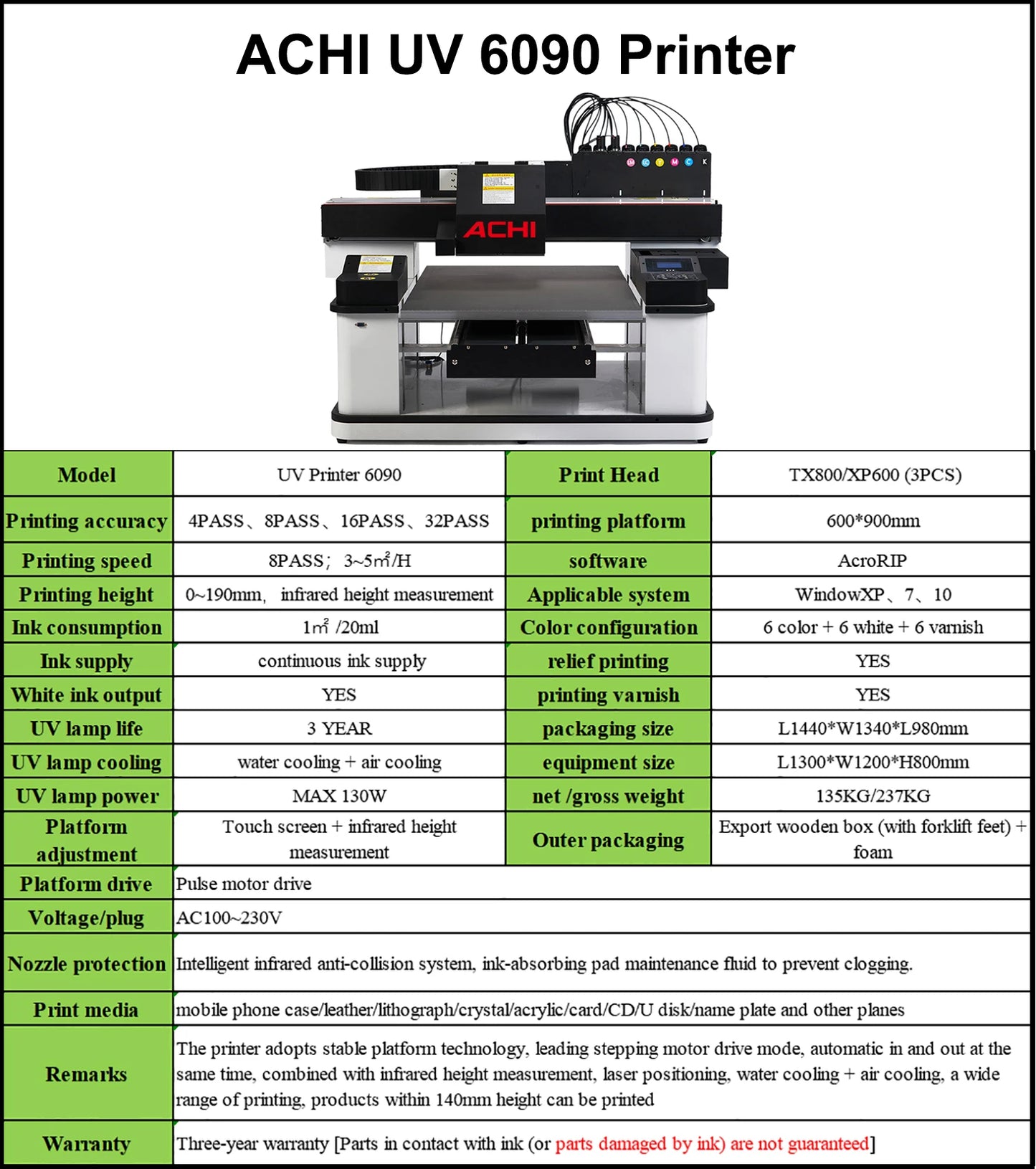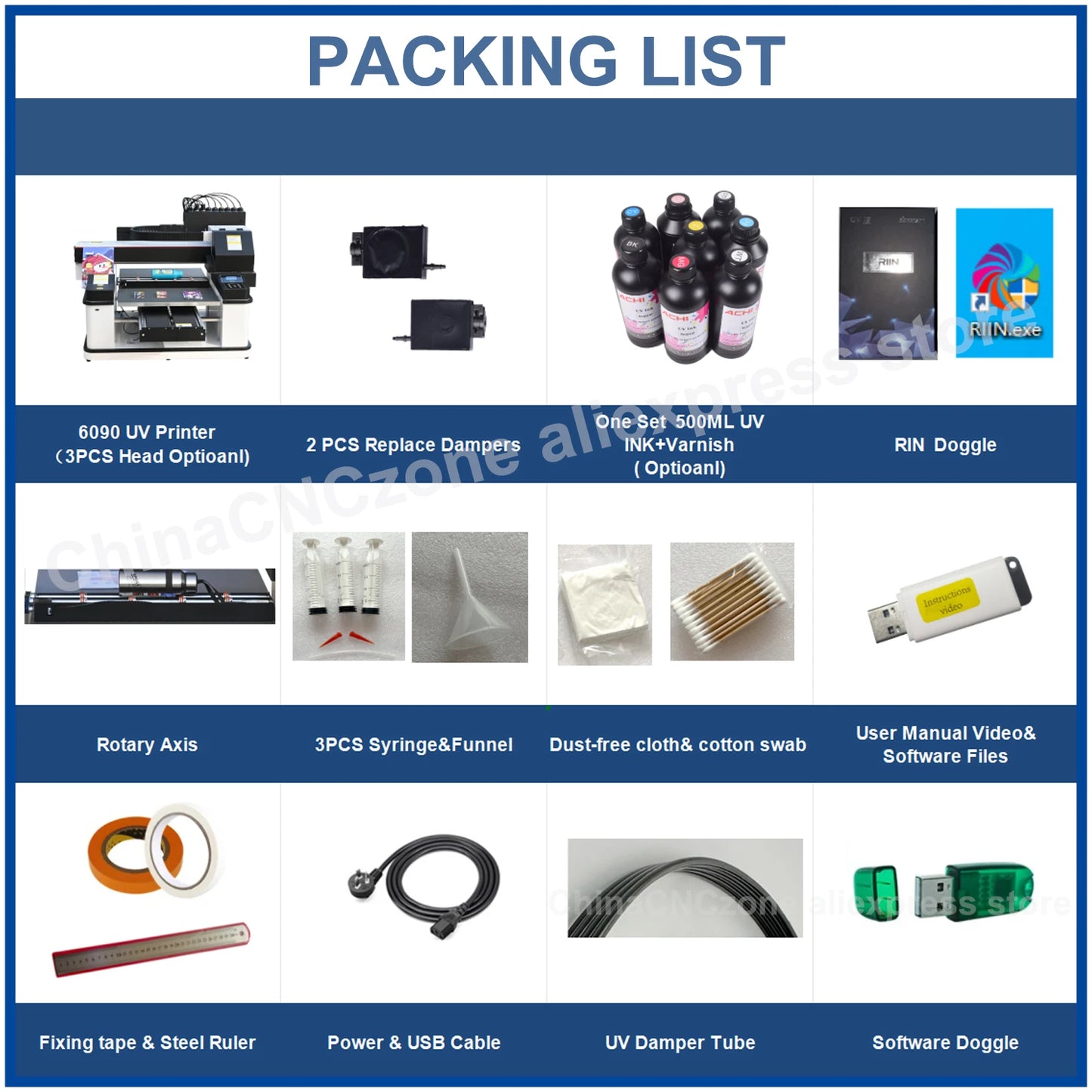calvarytechsolutions
A1 UV 6090 UV Printer EPSON 3PC XP600 Automatic Flatbed Printing
A1 UV 6090 UV Printer EPSON 3PC XP600 Automatic Flatbed Printing
Couldn't load pickup availability
SPECIFICATIONS
Key Features & Capabilities
Here is a more granular look at what each component of the specification implies, and what you should expect or verify when purchasing.
1. “A1 6090” / “6090 UV” Nomenclature
-
Print size / bed dimensions: The “6090” generally means a 600 × 900 mm (i.e. about 23.6″ × 35.4″) maximum printable area.
-
Media thickness / height clearance: Many 6090 models allow printing on substrates up to roughly 150–180 mm (or sometimes up to ~200 mm) thickness.
-
“A1” designation: Implies a “large-format / wide” flatbed size roughly in the realm of A1 (though a true A1 is 594 × 841 mm), so the nomenclature is a marketing alignment.
2. Print Heads – Epson “3PC XP600” + Alternatives
-
Many of these UV 6090 machines come with 3 Epson XP600 print heads (often custom‑modified or adapted for UV inks) to provide multiple color channels.
-
Some versions use TX800 or other types (or hybrid combinations) for better durability or different performance.
-
The “3PC” means three print heads, allowing different channel allocations (e.g. CMYK + W + V or distributing light colors).
-
The XP600 is a “variable-drop, piezoelectric” head; when used for UV, special handling (ink viscosity, heating, maintenance) is needed.
-
Print resolution capability is often advertised in the range of 720 × 2880 dpi (or similar) depending on pass mode and RIP software.
3. Color Channels: CMYKW + LC + LM + Varnish
-
CMYKW: Cyan, Magenta, Yellow, Black, White
-
LC + LM: Light Cyan, Light Magenta (to smooth gradients, reduce banding, improve color transitions)
-
V (Varnish or Gloss / Clear Coat): Used for protective coating or spot-UV / gloss effects
-
In sum, this gives up to 9 (or more) channels or “inks” that can be driven separately for advanced printing.
-
The machine often has a “closed / recirculation / negative pressure” ink system for white ink to prevent settling or clogging.
-
The varnish channel is sometimes used in the same pass (if head configuration allows) or in a separate pass for spot gloss effects.
4. Flatbed + Automatic Operation
-
Flatbed / vacuum bed: A stationary printing platform that holds rigid media (glass, acrylic, metal, wood, plastic, etc.) via vacuum suction or similar means.
-
Automatic / semi-automatic operation: The machine may have features like automatic height detection, automatic head cleaning / capping, blank-spot skipping, and auto head protection (spray flushing) when idle.
-
Servo / linear rail systems: For precise movement in X/Y axes and stability.
-
Ink management: Intelligent ink volume control, refilling “on the fly,” and ink level tracking are often integrated.
5. Rotary Axis
-
A rotary axis option enables printing on cylindrical or round objects (e.g. bottles, tubes, pens).
-
The machine would either have a built‑in rotary attachment or an add-on module to clamp and rotate cylindrical media under the print head.
-
This expands the machine’s versatility beyond flat objects to curved shapes.
6. Curing & UV System
-
LED UV lamps: The curing system is typically LED-based, with water-cooling or air + water cooling to maintain temperature stability and LED longevity.
-
Power / life: The UV lamp power is often in the tens of watts (e.g. 50 W or more), and promised life spans of LEDs may be 20,000–50,000 hours depending on cooling design.
-
Because UV curing is instantaneous, prints typically come out dry and ready immediately after printing (no drying time).
7. Performance & Throughput
-
Print speed / pass modes: Speeds depend on pass mode (higher passes → better quality but slower). Some published speeds:
-
8-pass mode: ~30 s per A3 (on smaller machines)
-
4-pass: ~3–10 m²/h (varies widely)
-
6-pass, 8-pass, 10-pass variants for different quality levels
-
-
Ink consumption: Often around 10 ml per m² (for CMYK or normal color coverage) in many listings.
-
Resolution: Up to 2880 × 720 dpi in many models; in high-quality modes effective resolution is often lower (but visually good).
8. Mechanical / Structural / Environmental Specs
-
Framework & motion: Linear guides, servo motors, stable aluminum or steel gantries to reduce vibration and ensure registration.
-
Height adjustment: Motorized or semi-automatic Z-axis adjustment for different substrate thicknesses.
-
Weight / dimensions: Often quite heavy (100–300+ kg) depending on frame and accessories.
-
Voltage / power: Many machines support 110V / 220V (50/60 Hz) input.
-
Working environment: Typical operating temperature ~20‑35 °C, humidity ~35‑80% RH.
-
Cooling / ventilation: UV lamp cooling, print head cooling, exhaust to vent ozone, if any (depending on lamp type).
9. Software / RIP / Controls
-
RIP software: Commonly supports Photoprint, Maintop, Onyx, etc.
-
File formats: TIFF, PNG, JPG, PDF, EPS, etc.
-
Operating system: Usually Windows-based control (Windows 7/10).
-
Connectivity: Ethernet / LAN, USB, sometimes gigabit networking.
10. Strengths
-
Versatility: Can print on nearly any flat rigid substrate (glass, acrylic, metal, wood, plastic, ceramic, leather, etc.).
-
Instant curing: No post-drying needed, minimal smudging, immediate handling.
-
Multi-channel capabilities: White, light colors, varnish, etc., allow advanced effects (spot varnish, emboss, raised printing).
-
One-pass or few-pass printing (in many cases) increases throughput.
| Parameter | Typical Value / Range |
|---|---|
| Maximum print area | 600 × 900 mm (23.6″ × 35.4″) |
| Maximum media height / thickness | ~ 150–180 mm (some denote up to ~200 mm) |
| Printheads | 3 × Epson XP600 (or hybrid with other types) |
| Color channels | CMYK + LC + LM + W + V (varnish) |
| Ink system | Closed-loop / recirculation / negative-pressure system, white ink circulation |
| Print resolution | Up to 720 × 2880 dpi (depending on mode) |
| Print speeds | Varies by passes: 4-pass, 6-pass, 8-pass, etc. (3–10 m²/h typical for many settings) |
| UV curing | LED UV lamp(s) with water cooling or air+water cooling |
| Power / voltage | 110 / 220 V, 50 / 60 Hz |
| Motion & mechanics | Servo motors, linear rails, vacuum flatbed, auto Z-height adjustment |
| Software / RIP | Photoprint, Maintop, Onyx, etc. |
| Machine weight / dimensions | Several hundred kg; footprint accordingly large |
Share
